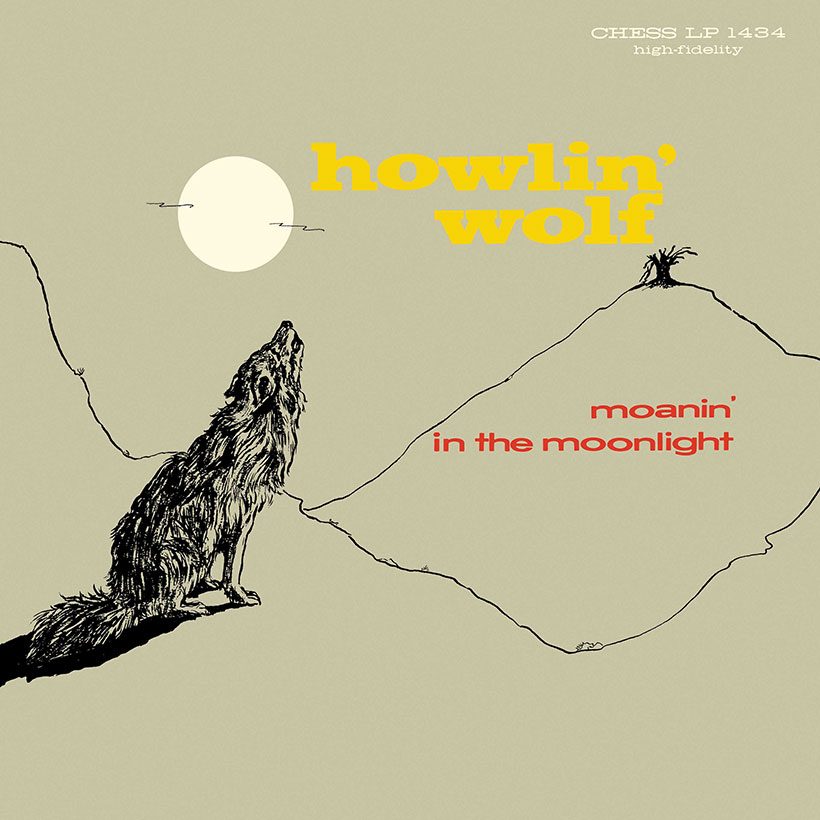‘Moanin’ In The Moonlight’: Howlin’ Wolf’s Primal Blues Scream
A collection of 50s singles, ‘Moanin’ In The Moonlight’ brought all of Howlin’ Wolf’s best qualities together: “a tail dragon with a voice like an angel”.

He was born Chester Arthur Burnett (and named after the 21st President of the United States) but took the name Howlin’ Wolf when he became a professional singer. Blues legend John Lee Hooker said of him that “the Mighty Wolf was a tail dragon with a voice like an angel,” and his debut album, the fittingly titled Moanin’ In The Moonlight, bore out that claim.
Wolf was an imposing man – he stood six feet, three inches, and weighed nearly 20 stone – and if his was an angel’s voice, it was a rough Delta blues angel, singing with a fierce growl and rasp that has never quite been matched by any singer since.
‘This is where the soul of man never dies’
All Wolf’s best qualities came together on the 1959 Chess album Moanin’ In The Moonlight, which collected together singles from 1951-59, including the stupendous “Smokestack Lightnin,’” a song he used to sing as a boy watching the trains go by in the Mississippi town in which he was born, on 10 June 1910. Wolf had been a farmer before making it as a musician at the age of 40, and would often talk to fellow musicians about the cash crop values of soy beans.
Sam Phillips, the founder of Sun Records, first heard Howlin’ Wolf in 1951 after an introduction from Ike Turner, and had an instantaneous emotional response to the man’s powerful voice. “I said, ‘This is for me. This is where the soul of man never dies,’” recalled Phillips.
The single “Moanin’ At Midnight” became Howlin’ Wolf’s first hit (Sun later leased the music to Chess Records). It is an eerie and powerful track, which opens memorably with Wolf humming in a deep throbbing style before launching into blazing harmonica and the words, “Yeah, somebody knockin’ on my door.” His voice has a hypnotic power, something the singer always talked about in self-deprecating terms. “I couldn’t do no yodellin’, so I turned to howlin’,” he joked. “And it’s done me just fine.”
The entirety of Moanin’ In The Moonlight is a gritty delight. Guitarist Willie Johnson was an inventive and elegant player, adding tone and rhythm to Wolf’s voice (he called the jazz nuances to his playing “my bop kick”), while drummer Willie Steele bashed away with unremitting power. Wolf, who learned the harmonica from Sonny Boy Williamson II, plays with genuine passion.
Hubert Sumlin, who adds lead guitar on some tracks, plays on almost all of these sessions, along with Otis Spann on piano and esteemed songwriter Willie Dixon on bass. Even the bit-part musicians were full of quality – including Otis “Big Smokey” Smother (a regular songwriter for Muddy Waters), who plays guitar on “I Asked For Water (She Gave Me Gasoline).” Fred Below, the man responsible for the drum sound on Chuck Berry’s “Johnny B Goode,” guests on “All Night Boogie.”
One of the excellent covers on the album is Roosevelt Sykes’ “Forty-Four Blues.” Sykes also penned the blues classic “Goin’ Down Slow.” “Forty-Four Blues,” a composition with origins in Louisiana in the 20s, was a favorite of Lowell George, who recorded a version with Little Feat.
The first rock’n’roll song
“How Many More Years,” a mid-tempo blues featuring Ike Turner on piano, was a genuinely innovative track. Robert Palmer said that the guitar by Johnson was the first in music to feature a “distorted power chord,” and celebrated producer T-Bone Burnett backed this view. As he explained: “In some ways, ‘How Many More Years’ by Howlin’ Wolf would be the first rock’n’roll song because that has the guitar lick that became the central guitar lick in rock’n’roll, and that’s the first time we heard that played on a distorted guitar. It was an old big-band lick, turned into something completely fresh.”
“Evil,” a song sometimes listed as “Evil (Is Going On)” was written by the master songwriter Willie Dixon and suited Wolf’s menacing delivery. It is no wonder that the singer proved such an inspirational figure for so many musicians, including The Doors, Cream, and The Rolling Stones.
The striking cover artwork was done by the late Don Bronstein, who later became the first staff photographer for Playboy, and in-house art director at Chess Records.
Wolf went on to have a glittering career and visited Europe numerous times. He had already suffered a heart attack before he visited London to record The London Howlin’ Wolf Sessions and, following a car accident in 1971, Wolf’s health went steadily downhill. Howlin’ Wolf died in 1976, having left his larger-than-life mark on the blues for all that came after him, particularly with this huge and unsettling masterpiece, which is ranked 154th on Rolling Stone’s list of the 500 greatest albums of all time.













Don Deering
December 12, 2022 at 1:30 pm
St. Louis Jimmy Odom gets the credit for “Going Down Slow.” I think Roosevelt Sykes wrote “Driving Wheel” and “Night Time Is the Right Time.”